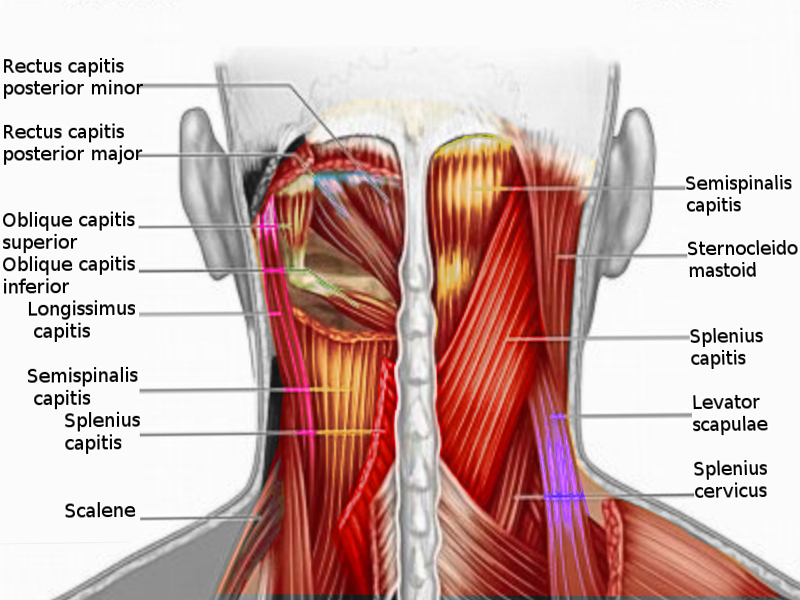[1]
Mnatsakanian A, Minutello K, Black AC, Bordoni B. Anatomy, Head and Neck, Retropharyngeal Space. StatPearls. 2023 Jan:():
[PubMed PMID: 30725729]
[3]
Zhang XY, Ma TT, Liu L, Yin NB, Zhao ZM. Anatomic study of the musculus longus capitis flap. Surgical and radiologic anatomy : SRA. 2017 Mar:39(3):271-279. doi: 10.1007/s00276-016-1708-8. Epub 2016 Jun 11
[PubMed PMID: 27289229]
[4]
Kennedy E, Albert M, Nicholson H. Do longus capitis and colli really stabilise the cervical spine? A study of their fascicular anatomy and peak force capabilities. Musculoskeletal science & practice. 2017 Dec:32():104-113. doi: 10.1016/j.msksp.2017.10.005. Epub 2017 Oct 16
[PubMed PMID: 29107220]
[5]
Boyd-Clark LC, Briggs CA, Galea MP. Muscle spindle distribution, morphology, and density in longus colli and multifidus muscles of the cervical spine. Spine. 2002 Apr 1:27(7):694-701
[PubMed PMID: 11923661]
[6]
Cohen MA, Evins AI, Lapadula G, Arko L, Stieg PE, Bernardo A. The rectus capitis lateralis and the condylar triangle: important landmarks in posterior and lateral approaches to the jugular foramen. Journal of neurosurgery. 2017 Dec:127(6):1398-1406. doi: 10.3171/2016.9.JNS16723. Epub 2017 Jan 27
[PubMed PMID: 28128694]
[7]
Gonzales JR, Iwanaga J, Oskouian RJ, Tubbs RS. Variant Prevertebral Muscle: Unique Cadaveric Findings. Cureus. 2017 Jul 25:9(7):e1515. doi: 10.7759/cureus.1515. Epub 2017 Jul 25
[PubMed PMID: 28959510]
[8]
Matsushima K, Funaki T, Komune N, Kiyosue H, Kawashima M, Rhoton AL Jr. Microsurgical anatomy of the lateral condylar vein and its clinical significance. Neurosurgery. 2015 Mar:11 Suppl 2():135-45; discussion 145-6. doi: 10.1227/NEU.0000000000000570. Epub
[PubMed PMID: 25255257]
[9]
Bogduk N. Functional anatomy of the spine. Handbook of clinical neurology. 2016:136():675-88. doi: 10.1016/B978-0-444-53486-6.00032-6. Epub
[PubMed PMID: 27430435]
[10]
Sakamoto Y. Spatial relationships between the morphologies and innervations of the scalene and anterior vertebral muscles. Annals of anatomy = Anatomischer Anzeiger : official organ of the Anatomische Gesellschaft. 2012 Jul:194(4):381-8. doi: 10.1016/j.aanat.2011.11.004. Epub 2011 Dec 8
[PubMed PMID: 22209543]
[11]
Iwanaga J, Fisahn C, Alonso F, DiLorenzo D, Grunert P, Kline MT, Watanabe K, Oskouian RJ, Spinner RJ, Tubbs RS. Microsurgical Anatomy of the Hypoglossal and C1 Nerves: Description of a Previously Undescribed Branch to the Atlanto-Occipital Joint. World neurosurgery. 2017 Apr:100():590-593. doi: 10.1016/j.wneu.2017.01.038. Epub 2017 Jan 19
[PubMed PMID: 28109859]
[12]
Gross JH, Zenga J, Sharon JD, Jackson RS, Pipkorn P. Longus Capitis Reconstruction of the Soft Palate. Otolaryngology--head and neck surgery : official journal of American Academy of Otolaryngology-Head and Neck Surgery. 2019 Sep:161(3):536-538. doi: 10.1177/0194599819849031. Epub 2019 May 14
[PubMed PMID: 31084255]
[13]
Day AT, Haughey BH, Rich JT. Prevertebral muscle flap for internal carotid artery coverage during oropharyngeal transoral surgery. The Laryngoscope. 2017 Oct:127(10):2256-2259. doi: 10.1002/lary.26542. Epub 2017 Apr 13
[PubMed PMID: 28407255]
[14]
Righi PD, Kelley DJ, Ernst R, Deutsch MD, Gaskill-Shipley M, Wilson KM, Gluckman JL. Evaluation of prevertebral muscle invasion by squamous cell carcinoma. Can computed tomography replace open neck exploration? Archives of otolaryngology--head & neck surgery. 1996 Jun:122(6):660-3
[PubMed PMID: 8639300]
[15]
Park MS, Moon SH, Kim TH, Oh JK, Kim HJ, Park KT, Riew KD. Surgical Anatomy of the Longus Colli Muscle and Uncinate Process in the Cervical Spine. Yonsei medical journal. 2016 Jul:57(4):968-72. doi: 10.3349/ymj.2016.57.4.968. Epub
[PubMed PMID: 27189293]
[16]
Narouze S. Ultrasound-guided stellate ganglion block: safety and efficacy. Current pain and headache reports. 2014 Jun:18(6):424. doi: 10.1007/s11916-014-0424-5. Epub
[PubMed PMID: 24760493]
[17]
Shen Y, Zhou Q, Zhu X, Qiu Z, Jia Y, Liu Z, Li S. Vertigo caused by longus colli tendonitis: A case report and literature review. Medicine. 2018 Nov:97(45):e13130. doi: 10.1097/MD.0000000000013130. Epub
[PubMed PMID: 30407336]
Level 2 (mid-level) evidence
[18]
Boardman J, Kanal E, Aldred P, Boonsiri J, Nworgu C, Zhang F. Frequency of acute longus colli tendinitis on CT examinations. Emergency radiology. 2017 Dec:24(6):645-651. doi: 10.1007/s10140-017-1537-z. Epub 2017 Jul 25
[PubMed PMID: 28744692]
[19]
Raggio BS,Ficenec SC,Pou J,Moore B, Acute Calcific Tendonitis of the Longus Colli. The Ochsner journal. 2018 Spring;
[PubMed PMID: 29559880]
[20]
Naik PP,Savery N,Kuruvilla L,Nayakar G,Raghul T, Longus Colli Tendinitis: The Lost Twin of Retropharyngeal Abscess. Indian journal of otolaryngology and head and neck surgery : official publication of the Association of Otolaryngologists of India. 2019 Oct;
[PubMed PMID: 31742062]
[21]
Farzal Z, Du E, Yim E, Mazul A, Zevallos JP, Huang BY, Hackman TG. Radiographic muscle invasion not a recurrence predictor in HPV-associated oropharyngeal squamous cell carcinoma. The Laryngoscope. 2019 Apr:129(4):871-876. doi: 10.1002/lary.27351. Epub 2018 Oct 16
[PubMed PMID: 30325502]
[22]
Tucciarone M, Taliente S, Gómez-Blasi Camacho R, Souviron Encabo R, González-Orús Álvarez-Morujo R. Extensive pyomyositis of prevertebral muscles after acupuncture: Case report. Turkish journal of emergency medicine. 2019 Jul:19(3):113-114. doi: 10.1016/j.tjem.2019.03.003. Epub 2019 Apr 4
[PubMed PMID: 31321345]
Level 3 (low-level) evidence
[23]
Vollmann R, Hammer G, Simbrunner J. Pathways in the diagnosis of prevertebral tendinitis. European journal of radiology. 2012 Jan:81(1):114-7. doi: 10.1016/j.ejrad.2011.02.061. Epub 2011 Mar 24
[PubMed PMID: 21439752]




